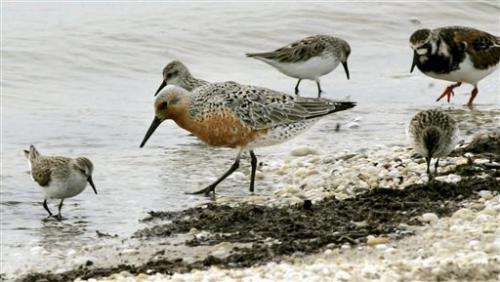US names red knot bird a threatened species

A rust-colored shorebird known for a nearly 20,000-mile migration will now receive federal protection, setting the stage for states to coordinate preservation plans for the dwindling species.
After a 14-month review, the U.S. Fish and Wildlife Service listed the rufa subspecies of the red knot as threatened on Tuesday. Under the Endangered Species Act, the ruling prohibits killing, shooting, hunting or otherwise harming the bird.
The threatened status means a plant or animal is likely to become endangered in the foreseeable future. Endangered means the species faces extinction.
"We've been—my wife and I—have been working hard to protect the animal with a group of people for 15 years now," said Larry Niles, a wildlife biologist and red knot expert with Conserve Wildlife N.J. "This status will give it a structural protection we've been seeking for a long time."
New Jersey already protects the bird, ruling the red knot endangered in 2012.
The bird has pencil-thin legs and a slender beak and migrates nearly 10,000 miles from South America to the Arctic every spring, reversing the trip in the fall. The birds can fly nearly 1,500 miles without rest.
One of those stops is along the Delaware Bay, where the birds' numbers have fallen from 100,000 to about 25,000.
The birds feed on clams and mussels. They also eat horseshoe crab eggs, which are rich in the nutrients that allow the birds to double their weight and make the trek.
"Imagine if you are driving across the country and there are only two or three pit stops to fuel up and get food and if you don't, it's all or nothing. Either you make it or you don't," said Eric Stiles, president of New Jersey Audubon.
The Fish and Wildlife Service links the decline to climate change and rising sea levels, which affect the bird's habitat and the availability of food.
"Although historic threats in the Delaware Bay area have been ameliorated thanks to the actions of federal and state partners, our changing climate is posing new and complex challenges to the red knot's habitat and food supply," Fish and Wildlife Service Director Dan Ashe said in a statement.
Because New Jersey already listed the bird as endangered, conservation efforts likely won't change drastically in the state, Stiles said. The bay is already a protected habitat, law enforcement helps protect the bird from harassment and funding for research is in place, he said.
The main advantage of the federal listing is cross-state coordination, Stiles said.
The bird is an incredible voyager. One earned the nickname Moonbird because researchers calculated it had flown enough miles to reach the moon and about half the way back, according to the Fish and Wildlife Service.
© 2014 The Associated Press. All rights reserved.
















